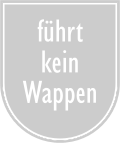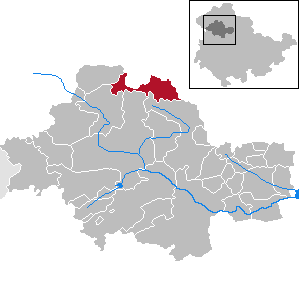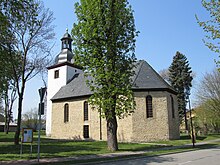Menteroda
| coat of arms | Germany map | |
|---|---|---|

|
Coordinates: 51 ° 18 ' N , 10 ° 34' E |
|
| Basic data | ||
| State : | Thuringia | |
| County : | Unstrut-Hainich district | |
| Height : | 431 m above sea level NHN | |
| Area : | 27.35 km 2 | |
| Residents: | 1920 (Dec. 31, 2019) | |
| Population density : | 70 inhabitants per km 2 | |
| Postcodes : | 99996, 99976 (Kleinkeula, Sollstedt) |
|
| Area code : | 036029 | |
| License plate : | UH, LSZ, MHL | |
| Community key : | 16 0 64 072 | |
| LOCODE : | DE MTA | |
| Community structure: | 4 districts | |
| Address of the municipal administration: |
Holzthalebener Str. 38 99996 Menteroda |
|
| Website : | ||
| Mayor : | Martin Wacker | |
| Location of the community of Menteroda in the Unstrut-Hainich district | ||
Menteroda is a municipality in the Unstrut-Hainich district in Thuringia .
geography
Menteroda is located south of the village of Keula on state road 2093 and on the northern roof of the Mühlhäuser Hardt forest area .
Community structure
The four districts of the municipality are:
- Kleinkeula
- Menteroda
- Sollstedt
- Urbach
history
From 1545 the place belonged to the Saxon office of Volkenroda , which belonged as an exclave to the Duchy of Saxe-Gotha from 1645 , from 1672 to the Duchy of Saxe-Gotha-Altenburg and from 1826 to the Duchy of Saxe-Coburg and Gotha . In 1920 the place came to the state of Thuringia.
On August 1, 1996, the previously independent communities of Kleinkeula, Menteroda, Sollstedt and Urbach merged to form the new unitary community of Menteroda, thus dissolving the administrative community of Menteroda .
church
Mining history

From 1906 to 1991 Menteroda was the seat of a mining company in the southern Harz mining region for the extraction of potash salts . The actual potash mining in the Gotha exclave of Volkenroda began around 1900. On August 16, 1905, the Ohrdruf Mining Authority approved the exploratory drilling of the Volkenroda union, which was being founded. The company planned as a stock corporation should only be formed with successful prospecting. Gustav Kost , who came from Hanover , had developed a plan for the establishment of potash mines together with the Hamburg industrialist Kommerzienrat Gustav Stähr and the industrialist Gustav Starke , who lived in Beienrode (Königslutter), based on the geological reports, and had an influential supporter in the Gotha banker Albert Linz and financiers found. On October 19, 1905, exploratory drilling (Deutsche Tiefbohr AG Nordhausen) began in the Menteroda corridor “Am Triftgraben”, and another drilling rig was on the road to Holzthaleben . On July 4, 1906, a depth of about 1040 m was reached and the immediately evaluated drill cores prompted Linz to request a mining officer from Ohrdruf to present samples obtained in his presence for official permission.
Construction of the “Karl Eduard” shaft of the Volkenroda potash union began on August 28, 1906 , about 500 m from the outskirts of Menteroda; the first shaft had a diameter of 5.5 m. In order to obtain the necessary labor and land in the shortest possible time, the farmers were offered small shares instead of cash. The value of these stocks should multiply in a short period of time.
The construction of the first shaft proceeded with great technical difficulties: In 1906 the shaft depth was 110 m, then a strong water ingress (350 l / min) stopped the work. In 1907 a depth of 423 m was reached. New water-bearing layers (up to 450 l / min) constantly had to be registered and sealed. High-performance pumps (duplex pumps) had to be procured for pumping out. At the end of 1908 you had (only) reached a depth of 808 m. The potash salt was approached in mid-May 1909 at a depth of 977.5 m; on May 22, 1909, the rock layer below the potash salt was reached at a depth of 1001 m.
Up until the completion of the mine’s own mine railway in 1908, the mining equipment and the necessary building materials had to be transported by horse and cart from the Holzthaleben freight loading platform. The 2.4 km long siding to the Greußen-Ebeleben-Keulaer Railway was completed in the summer of 1908. Shaft construction specialists from the Ruhr area were recruited for a lot of work and were housed in a barracks settlement on the outskirts. During the war years 1917 and 1918, prisoners of war were used in the union's salt mines. Potash mining flourished after the First World War , in 1919 the Menterodaer mining field was connected to the Pöthen I shaft, which belongs to the union , and Pöthen II shaft was also connected later. These two Pöthen shafts were completed in 1910 and 1913, but never reached full mining operations.
The pits were demolished after closure of a firm partly the pits with rubble, earth and industrial waste filled and the slag heap largely rehabilitated. At the former shaft there is now a mining museum with a display system. The location was developed into the Menteroda industrial park.
politics
Municipal council
The council of the municipality of Menteroda has consisted of 12 councilors and councilors since 2019. It is re-elected every five years.
| Parties and constituencies | 2019 | 2014 | 2009 | 2004 | 1999 | 1994 | ||||||||||||
|---|---|---|---|---|---|---|---|---|---|---|---|---|---|---|---|---|---|---|
| Share a | Seats | Share a | Seats | Share a | Seats | Share a | Seats | Share a | Seats | Share a | Seats | |||||||
| Christian Democratic Union of Germany | CDU | 23.7 | 3 | 16.7 | 2 | - | - | 22.7 | 3 | 28.1 | 4th | 25.2 | 3 | |||||
| Social Democratic Party of Germany | SPD | 10.3 | 1 | 13.4 | 2 | 24.7 | 4th | 24.4 | 3 | 31.4 | 4th | 49.4 | 7th | |||||
| Free voter community Menteroda b | FWG | 66.0 | 8th | 69.9 | 10 | 57.8 | 8th | 42.5 | 6th | 18.4 | 3 | - | - | |||||
| Voting group Sport Urbach | WSU | - | - | - | - | 17.5 | 2 | 10.4 | 2 | 6.1 | 1 | - | - | |||||
| Democratic Socialism Party | PDS | - | - | - | - | - | - | - | - | 11.1 | 2 | 6.0 | 1 | |||||
| Free Democratic Party | FDP | - | - | - | - | - | - | - | - | 4.9 | - | 7.1 | 1 | |||||
| Citizens' Community Menteroda | BG | - | - | - | - | - | - | - | - | - | - | 12.3 | 2 | |||||
| percentage of invalid votes | 4.0 | 4.6 | 7.6 | 4.1 | 2.2 | 3.7 | ||||||||||||
| Total seats | 12 | 14th | 14th | 14th | 14th | 14th | ||||||||||||
| voter turnout | 67.0% | 60.7% | 63.7% | 62.8% | 66.7% | 82.9% | ||||||||||||
mayor
The full-time mayor Martin Wacker was elected on January 14, 2007. He was last re-elected on November 4, 2018 with 96.6% of the vote.
sons and daughters of the town
- Hans Grodotzki (born April 4, 1936), athlete and Olympic medalist
Others
- Because of his darker complexion, the miner's son Georg Kurzewsky was declared a “ Gypsy hybrid” by the mayor, who was also a registrar, during the National Socialist era and was therefore forcibly sterilized .
- As evidence of an often coarse folk humor, neck names and nicknames that characterize each village developed centuries ago . Accordingly, there lived here in the village of Menterodaer Kricken - from Krücke also broom- makers - reason: The stick-making and broom- making trade was widespread in the village.
Individual evidence
- ^ Population of the municipalities from the Thuringian State Office for Statistics ( help on this ).
- ^ StBA: Changes in the municipalities in Germany, see 1996 .
- ↑ City council elections 2019 in Thuringia - final result. In: wahlen.thüringen.de. Retrieved July 6, 2019 .
- ↑ 2014 municipal council elections in Thuringia - final result. In: wahlen.thüringen.de. Retrieved March 4, 2018 .
- ↑ 2009 municipal council elections in Thuringia - final result. In: wahlen.thüringen.de. Retrieved March 4, 2018 .
- ^ 2004 municipal council elections in Thuringia - final result. In: wahlen.thüringen.de. Retrieved March 4, 2018 .
- ^ 1999 municipal council elections in Thuringia - final result. In: wahlen.thüringen.de. Retrieved March 4, 2018 .
- ^ 1994 municipal council elections in Thuringia - final result. In: wahlen.thüringen.de. Retrieved March 4, 2018 .
- ↑ Mayoral elections in Thuringia - election of January 14, 2007. In: wahlen.thüringen.de. Retrieved March 6, 2018 .
- ↑ Mayoral elections in Thuringia - election on November 4th, 2018. In: wahlen.thüringen.de. Retrieved July 6, 2019 .
- ↑ Thuringian Association of the Persecuted of the Nazi Regime - Association of Antifascists and Study Group of German Resistance 1933–1945 (Ed.): Local history guide to sites of resistance and persecution 1933–1945. Volume 8: Thuringia. VAS - Verlag für Akademische Schriften, Frankfurt am Main 2003, ISBN 3-88864-343-0 , p. 307.
- ↑ Rolf Aulepp: Nicknames of the places and their residents in the Mühlhausen district. In: Eichsfelder Heimathefte. Vol. 27, No. 1, 1987, ISSN 0232-8518 , pp. 78-83.




